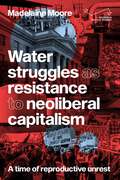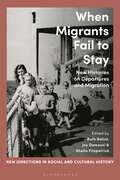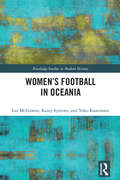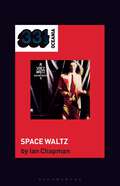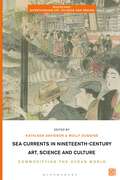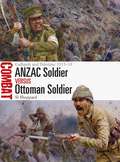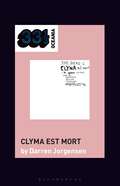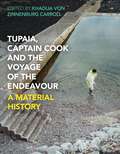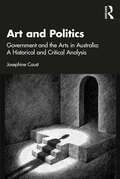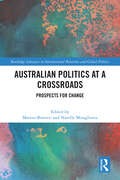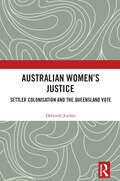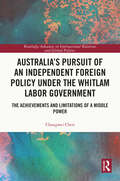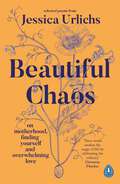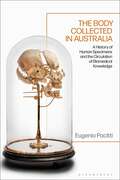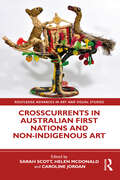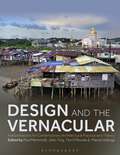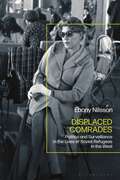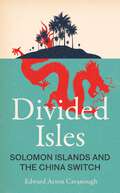- Table View
- List View
Water struggles as resistance to neoliberal capitalism: A time of reproductive unrest (Progress in Political Economy)
by Madelaine MooreThis book provides an important intervention into social reproduction theory and the politics of water. Presenting an incorporated comparison, it analyses the conjuncture following the 2007 financial crisis through the lens of water expropriation and resistance. This brings into view the way that transnational capital has made use of and been facilitated by the strategic selectivities of both the Irish and the Australian state, as well as the particular class formations that emerged in resistance to such water grabs. What is revealed is a crisis-ridden system that is marked by increasing reproductive unrest – class understood through the lens of social reproduction theory. As an important analysis of two significant water struggles, the book makes a compelling argument for integrating the study of social movements within critical political economy.
When Migrants Fail to Stay: New Histories on Departures and Migration (New Directions in Social and Cultural History)
by Ruth Balint, Joy Damousi, and Sheila FitzpatrickThe aftermath of the Second World War marked a radical new moment in the history of migration. For the millions of refugees stranded in Europe, China and Africa, it offered the possibility of mobility to the 'new world' of the West; for countries like Australia that accepted them, it marked the beginning of a radical reimagining of its identity as an immigrant nation. For the next few decades, Australia was transformed by waves of migrants and refugees. However, two of the five million who came between 1947 and 1985 later left. When Migrants Fail to Stay examines why this happened. This innovative collection of essays explores a distinctive form of departure, and its importance in shaping and defining the reordering of societies after World War II. Esteemed historians Ruth Balint, Joy Damousi, and Sheila Fitzpatrick lead a cast of emerging and established scholars to probe this overlooked phenomenon. In doing so, this book enhances our understanding of the migration and its history.
Women’s Football in Oceania (Routledge Studies in Modern History)
by Lee McGowan Kasey Symons Yoko KanemasuThis book presents the most comprehensive mapping and analysis of women’s football in Oceania and is the first to examine the game’s historical development alongside social, political and cultural issues, weaving origin stories with players’ day-to-day challenges. Alongside presentation of the contemporary state of play and its overarching narrative of women’s game in the region, the book highlights key issues, discusses established and emergent themes, examines relevant contexts, investigates the status of the game at local and national levels and lays foundations for further research. Its primary objective is to detail and illustrate the historical, social, and organisational development of the women’s game, including international tournaments, national competitions, and teams in an effort to amplify the efforts of the individuals that made or make a significant contribution to the game. It draws on extensive formal and informal discussion, realises insight, proposes the means and related fields of further investigation and generates new knowledge alongside the uncovering of old. Women’s Football in Oceania covers key events, actors and moments and fills a gap in research for scholars of sports history and women’s history.
Women’s Football in Oceania (Routledge Studies in Modern History)
by Lee McGowan Kasey Symons Yoko KanemasuThis book presents the most comprehensive mapping and analysis of women’s football in Oceania and is the first to examine the game’s historical development alongside social, political and cultural issues, weaving origin stories with players’ day-to-day challenges. Alongside presentation of the contemporary state of play and its overarching narrative of women’s game in the region, the book highlights key issues, discusses established and emergent themes, examines relevant contexts, investigates the status of the game at local and national levels and lays foundations for further research. Its primary objective is to detail and illustrate the historical, social, and organisational development of the women’s game, including international tournaments, national competitions, and teams in an effort to amplify the efforts of the individuals that made or make a significant contribution to the game. It draws on extensive formal and informal discussion, realises insight, proposes the means and related fields of further investigation and generates new knowledge alongside the uncovering of old. Women’s Football in Oceania covers key events, actors and moments and fills a gap in research for scholars of sports history and women’s history.
Alastair Riddell’s Space Waltz (33 1/3 Oceania)
by Ian ChapmanAlastair Riddell's band Space Waltz was a short-lived one-album New Zealand rock act who hit gold with a #1 hit single in October 1974 with the song 'Out On The Street' but thereafter failed to achieve anything even close to that feat. While relegated to one-hit-wonder status in the eyes of many, to this day Riddell and Space Waltz epitomize the mid-1970s heyday of glam rock in New Zealand. But in truth their impact went far beyond this. Their generationally divisive nation-wide debut on the hugely popular MOR television talent quest Studio One/New Faces demonstrated the power of mass media exposure – they were instantly signed to a record deal with industry giant EMI – while Riddell's controversial gender-bending image provided a cultural crossroads that greatly impacted the wider youth culture of Aotearoa New Zealand. In addition, while the album's most famous track, 'Out On The Street,' is rightly regarded as New Zealand's glam rock anthem, the wider album demonstrates a compositional and musical depth that goes far beyond glam rock and into the realm of sophisticated progressive rock, ultimately providing an unlikely and highly unique musical amalgam.
Sea Currents in Nineteenth-Century Art, Science and Culture: Commodifying the Ocean World (Biotechne: Interthinking Art, Science and Design)
How did scientists, artists, designers, manufacturers and amateur enthusiasts experience and value the sea and its products? Examining the commoditization of the ocean world during the nineteenth century, this book demonstrates how the transaction of oceanic objects inspired a multifaceted material discourse stemming from scientific exploration, colonial expansion, industrialization, and the rise of middle-class leisure. From the seashore to the seabed, marine organisms and environments, made tangible through processing and representational technologies, captivated practitioners and audiences. Combining essays and case studies by scholars, curators, and scientists, Sea Currents investigates the collecting and display, illustration and ornamentation, and trade and consumption of marine flora and fauna, analysing their material, aesthetic and commercial dimensions. Traversing global art history, the history of science, empire studies, anthropology, ecocriticism and material culture, this book surveys the currency of marine matter embedded in the economies and ecologies of a modernizing ocean world.
ANZAC Soldier vs Ottoman Soldier: Gallipoli and Palestine 1915–18 (Combat)
by Si SheppardIn 1915–18, ANZAC and Ottoman soldiers clashed on numerous battlefields, from Gallipoli to Jerusalem. This illustrated study investigates the two sides' fighting men.The Gallipoli campaign of 1915–16 pitched the Australian and New Zealand volunteers known as the ANZACs into a series of desperate battles with the Ottoman soldiers defending their homeland. In August 1915, the bitter struggle for the high ground known as Chunuk Bair saw the peak change hands as the Allies sought to overcome the stalemate that set in following the landings in April. The ANZACs also played a key part in the battle of Lone Pine, intended to divert Ottoman attention away from the bid to seize Chunuk Bair. The Gallipoli campaign ended in Allied evacuation in the opening days of 1916. Thereafter, many ANZAC units remained in the Middle East and played a decisive role in the Allies' hard-fought advance through Palestine that finally forced the Turks to the peace table. The fateful battle of Beersheba in October 1917 pitted Australian mounted infantry against Ottoman foot soldiers as the Allies moved on Jerusalem. In this book, noted military historian Si Sheppard examines the fighting men on both sides who fought at Lone Pine, Chunuk Bair and Beersheba. The authoritative text is supported by specially commissioned artwork and mapping plus carefully chosen archive photographs.
The Dead C’s Clyma est mort (33 1/3 Oceania)
by Darren JorgensenThe Dead C's Clyma est mort (1993) is the record of a live gig for one person. Tom Lax was running the Siltbreeze label in Philadelphia and had come to New Zealand to meet the artists he was releasing. He heard The Dead C at their noisy, improvised best, turning rock music on its head with a free-form style of blaring, loosely organised sound. Leading a second wave of music from Dunedin, New Zealand, The Dead C were an assault against the kind of jangly pop that had made the Dunedin Sound famous during the 1980s. This book uses The Dead C and in particular their album Clyma est mort (1993) to offer insights into the way the best of rock music plays vertigo with our senses, illustrating a sonic picture of freedom and energy. It places the album into the history of independent music in New Zealand, and into an international context of independent labels posting, faxing and phoning each other.
Tupaia, Captain Cook and the Voyage of the Endeavour: A Material History
Centring priest and navigator Tupaia and Pacific worldviews, this richly illustrated volume weaves a new set of cultural histories in the Pacific, between local islanders and the crew of the Endeavour on James Cook's first 'voyage of discovery' (1768-1771). Contributors consider material collections brought back from the voyage, paying particular attention to Tupaia's drawings, maps, cloth and clothes, and the attending narratives that framed Britain's engagement with Pacific peoples. Bringing together indigenous and Pacific-based artists, scholars, historians, theorists and tailors, this book presents a cross-cultural conversation around the concepts of acquired and curated artefacts that traversed oceans and entwined cultures. Each chapter draws attention to a particular material, object or process to reveal fresh insights on the voyage, the societies it brought together and the histories it transformed. Authors also explore animal iconography, instruments and ethnomusicology, and performances and rituals. This work challenges colonial museum collections and celebrations of Cook's voyages, using materials old and new to make connections between past and present, whilst reinforcing Tupaia's agency as both a historical figure and a contemporary muse. Tracing overlapping folds of symbolism, this book draws together a picture of the diverse materials and people at the centre of cultural exchange.
When Migrants Fail to Stay: New Histories on Departures and Migration (New Directions in Social and Cultural History)
The aftermath of the Second World War marked a radical new moment in the history of migration. For the millions of refugees stranded in Europe, China and Africa, it offered the possibility of mobility to the 'new world' of the West; for countries like Australia that accepted them, it marked the beginning of a radical reimagining of its identity as an immigrant nation. For the next few decades, Australia was transformed by waves of migrants and refugees. However, two of the five million who came between 1947 and 1985 later left. When Migrants Fail to Stay examines why this happened. This innovative collection of essays explores a distinctive form of departure, and its importance in shaping and defining the reordering of societies after World War II. Esteemed historians Ruth Balint, Joy Damousi, and Sheila Fitzpatrick lead a cast of emerging and established scholars to probe this overlooked phenomenon. In doing so, this book enhances our understanding of the migration and its history.
Art and Politics: Government and the Arts in Australia: A Historical and Critical Analysis
by Josephine CaustAustralian governments at all levels have been engaged with arts and culture in many different forms since the beginning of European settlement. The way this has occurred is documented and analysed here, both from an historical and critical perspective. Changing understandings of culture and the significance of Indigenous Culture to Australia receive special attention. While the focus is primarily directed to Federal Government engagement, there is also consideration paid to both state and local government involvement. There is attention paid to the censorship of arts practice by governments as well as the direct interventions by politicians in arts practice. Different approaches to the arts by governments are also considered, as well as attempts to develop a national cultural policy. The impact of the recent pandemic is addressed and various research reports about the arts sector and its relationship with government are also noted. There is then a final discussion about some issues that governments could address in the future, that might ensure a more sustainable Australian arts sector. This book will be of particular interest to scholars of contemporary arts, arts management, cultural history, public policy and cultural policy. It may also interest bureaucrats and politicians.
Art and Politics: Government and the Arts in Australia: A Historical and Critical Analysis
by Josephine CaustAustralian governments at all levels have been engaged with arts and culture in many different forms since the beginning of European settlement. The way this has occurred is documented and analysed here, both from an historical and critical perspective. Changing understandings of culture and the significance of Indigenous Culture to Australia receive special attention. While the focus is primarily directed to Federal Government engagement, there is also consideration paid to both state and local government involvement. There is attention paid to the censorship of arts practice by governments as well as the direct interventions by politicians in arts practice. Different approaches to the arts by governments are also considered, as well as attempts to develop a national cultural policy. The impact of the recent pandemic is addressed and various research reports about the arts sector and its relationship with government are also noted. There is then a final discussion about some issues that governments could address in the future, that might ensure a more sustainable Australian arts sector. This book will be of particular interest to scholars of contemporary arts, arts management, cultural history, public policy and cultural policy. It may also interest bureaucrats and politicians.
Australian Politics at a Crossroads: Prospects for Change (ISSN)
As the 21st century proceeds apace, Australia faces new and old challenges, both domestically and internationally. These include managing complex governance issues, preventing democratic fracture, balancing an ever- shifting geopolitical strategic order, addressing the recognition and identity demands of marginalised groups, and responding to crises and urgent policy challenges, such as climate change.Bonotti, Miragliotta, and the other contributors to this volume analyse and evaluate the challenges which confront Australia by locating them in their national and comparative context. The various contributions reveal that while these challenges are neither novel nor unique to Australia, the way in which they manifest and Australia’s responses to them are shaped by the country’s distinctive history, culture, geography, location, and size.The chapters offer a cutting- edge analysis of these pressing challenges faced by Australia and offer reflections on how to address them. The book is a valuable resource for scholars and students of Australian politics, and of comparative politics in a global perspective.
Australian Politics at a Crossroads: Prospects for Change (ISSN)
by Matteo Bonotti Narelle MiragliottaAs the 21st century proceeds apace, Australia faces new and old challenges, both domestically and internationally. These include managing complex governance issues, preventing democratic fracture, balancing an ever- shifting geopolitical strategic order, addressing the recognition and identity demands of marginalised groups, and responding to crises and urgent policy challenges, such as climate change.Bonotti, Miragliotta, and the other contributors to this volume analyse and evaluate the challenges which confront Australia by locating them in their national and comparative context. The various contributions reveal that while these challenges are neither novel nor unique to Australia, the way in which they manifest and Australia’s responses to them are shaped by the country’s distinctive history, culture, geography, location, and size.The chapters offer a cutting- edge analysis of these pressing challenges faced by Australia and offer reflections on how to address them. The book is a valuable resource for scholars and students of Australian politics, and of comparative politics in a global perspective.
Australian Women's Justice: Settler Colonisation and the Queensland Vote
by Deborah JordanThis book explores how women spearheaded the democratic suffrage campaign in colonial Queensland engaging with international debates on women’s activism, leadership, advocacy, print culture, and social movements. Australian Women's Justice provides a nuanced reading of the diversity and differences of the women’s movement in Queensland, from the time of first white colonisation, federation to World War 1 by new research on key women’s organisations: notably the Women’s Equal Franchise Association and the Women’s Peace Army. Framed through the lives of women suffrage participants, including their encounters with First Nations women, it also looks beyond microhistory to explore broader themes of the intersection of race, gender, property, war, and empire in the colonial context. Campaigns for enfranchisement and property rights and against conscription connect this story with larger international movements for women and labour, and organisations such as the League of Nations. This book will be of interest to students and researchers of Australian feminism and suffragism, as well as historians of feminist, labour, and peace movements both in Australia and internationally.
Australian Women's Justice: Settler Colonisation and the Queensland Vote
by Deborah JordanThis book explores how women spearheaded the democratic suffrage campaign in colonial Queensland engaging with international debates on women’s activism, leadership, advocacy, print culture, and social movements. Australian Women's Justice provides a nuanced reading of the diversity and differences of the women’s movement in Queensland, from the time of first white colonisation, federation to World War 1 by new research on key women’s organisations: notably the Women’s Equal Franchise Association and the Women’s Peace Army. Framed through the lives of women suffrage participants, including their encounters with First Nations women, it also looks beyond microhistory to explore broader themes of the intersection of race, gender, property, war, and empire in the colonial context. Campaigns for enfranchisement and property rights and against conscription connect this story with larger international movements for women and labour, and organisations such as the League of Nations. This book will be of interest to students and researchers of Australian feminism and suffragism, as well as historians of feminist, labour, and peace movements both in Australia and internationally.
Australia’s Pursuit of an Independent Foreign Policy under the Whitlam Labor Government: The Achievements and Limitations of a Middle Power (Routledge Advances in International Relations and Global Politics)
by Changwei ChenThe election of the Whitlam-led Labor government in December 1972 ushered in fresh ideas and audacious initiatives in Australia’s foreign policy. Whitlam’s approach was shaped by a vision of taking Australia forward to its "rightful" and "independent" place in the future of the Asia Pacific region. Examining a series of episodes in Australia’s foreign relations under Whitlam, Chen pays attention to a broad range of hitherto insufficiently researched domestic and international issues in Australian’s foreign relations of the early 1970s. They range from immigration policy and the abolition of appeals from Australian Courts to the Privy Council to such major international issues as the Anglo-American base in Diego Garcia, French nuclear testing in the Pacific and the Five Power Agreement with respect to Malaysia and Singapore. Chen demonstrates how the pursuit of foreign policy independence repeatedly placed the Whitlam Government in a position wedged in between Australia’s traditional allies and the Third World; and how it navigated Australia’s national interests on a series of dilemma situations involving conflicting strategic interests between Australia and its traditional allies, and those between major powers and the non-aligned countries. The analysis presented in this book contributes to not only historical literature on the subject but also to the understanding of how a middle power, like Australia, can navigate intensifying great power rivalry. Essential reading for scholars of Australian foreign policy, as well as being an invaluable case study of Middle Power diplomacy in the Asia Pacific region.
Australia’s Pursuit of an Independent Foreign Policy under the Whitlam Labor Government: The Achievements and Limitations of a Middle Power (Routledge Advances in International Relations and Global Politics)
by Changwei ChenThe election of the Whitlam-led Labor government in December 1972 ushered in fresh ideas and audacious initiatives in Australia’s foreign policy. Whitlam’s approach was shaped by a vision of taking Australia forward to its "rightful" and "independent" place in the future of the Asia Pacific region. Examining a series of episodes in Australia’s foreign relations under Whitlam, Chen pays attention to a broad range of hitherto insufficiently researched domestic and international issues in Australian’s foreign relations of the early 1970s. They range from immigration policy and the abolition of appeals from Australian Courts to the Privy Council to such major international issues as the Anglo-American base in Diego Garcia, French nuclear testing in the Pacific and the Five Power Agreement with respect to Malaysia and Singapore. Chen demonstrates how the pursuit of foreign policy independence repeatedly placed the Whitlam Government in a position wedged in between Australia’s traditional allies and the Third World; and how it navigated Australia’s national interests on a series of dilemma situations involving conflicting strategic interests between Australia and its traditional allies, and those between major powers and the non-aligned countries. The analysis presented in this book contributes to not only historical literature on the subject but also to the understanding of how a middle power, like Australia, can navigate intensifying great power rivalry. Essential reading for scholars of Australian foreign policy, as well as being an invaluable case study of Middle Power diplomacy in the Asia Pacific region.
Beautiful Chaos: On Motherhood, Finding Yourself and Overwhelming Love
by Jessica UrlichsThe perfect gift for mums and mums-to-be this Mother’s Day'The words awaken the magic of life by celebrating the ordinary' - Giovanna Fletcher'Beautifully heartfelt, inspiringly poignant and therapeutically validating' - Anna Mathur Motherhood is messy and beautiful, and hard and humbling. We adore our children, and sometimes we miss ourselves. Beautiful Chaos is a collection of raw, honest poems about motherhood - capturing everything from pregnancy to school age. Upon becoming a mother, poet Jessica Urlichs was reminded that the everyday ordinary is extraordinary. Beautiful Chaos is a collection that chronicles it all - the highs, the lows, the confusion, the loss of identity, the becoming, and the brutal but beautiful ways our children hold up a mirrors to ourselves. This collection inspires vulnerability and will be a cathartic, healing read for anyone who needs it. These poems will remind you of a time gone by or ground you in the current moment. Either way, they will make you feel seen and comforted amid the beautiful chaos that is motherhood.
The Body Collected in Australia: A History of Human Specimens and the Circulation of Biomedical Knowledge
by Eugenia PacittiOffering insight into nineteenth- and early twentieth-century medical school dissecting rooms and anatomy museums, this book explores how collected human remains have shaped Western biomedical knowledge and attitudes towards the body. To explore the role Australia played in the narrative of Western medical development, Pacitti focuses on how and why Australian anatomists and medical students obtained human body parts. As medical knowledge circulated between Australia and Britain, the colony's physicians conformed to established specimen collecting practices and diverged from them to form a distinct medical identity. Interrogating how these literal and figurative bones of contention have left an indelible mark on the nation's medical profession, collecting institutions, and communities, Pacitti sheds new light on our understanding of Western medical networks and reveals the opportunities and challenges historic specimen collections pose in the present day.The Body Collected in Australia is a cultural history of collectors and collections that deepens our understanding of the ways the living have used the dead to comprehend the intricacies of the human body in illness and good health.
Crosscurrents in Australian First Nations and Non-Indigenous Art (Routledge Advances in Art and Visual Studies)
This edited collection examines art resulting from cross-cultural interactions between Australian First Nations and non-Indigenous people, from the British invasion to today. Focusing on themes of collaboration and dialogue, the book includes two conversations between First Nations and non-Indigenous authors and an historian’s self-reflexive account of mediating between traditional owners and an international art auction house to repatriate art. There are studies of ‘reverse appropriation‘ by early nineteenth-century Aboriginal carvers of tourist artefacts and the production of enigmatic toa. Cross-cultural dialogue is traced from the post-war period to ‘Aboriginalism’ in design and the First Nations fashion industry of today. Transculturation, conceptualism, and collaboration are contextualised in the 1980s, a pivotal decade for the growth of collaborative First Nations exhibitions. Within the current circumstances of political protest in photographic portraiture and against the mining of sacred Aboriginal land, Crosscurrents in Australian First Nations and Non-Indigenous Art testifies to the need for Australian institutions to collaborate with First Nations people more often and better. This book will appeal to students and scholars of art history, Indigenous anthropology, and museum and heritage studies.
Crosscurrents in Australian First Nations and Non-Indigenous Art (Routledge Advances in Art and Visual Studies)
by Sarah Scott Helen McDonald Caroline JordanThis edited collection examines art resulting from cross-cultural interactions between Australian First Nations and non-Indigenous people, from the British invasion to today. Focusing on themes of collaboration and dialogue, the book includes two conversations between First Nations and non-Indigenous authors and an historian’s self-reflexive account of mediating between traditional owners and an international art auction house to repatriate art. There are studies of ‘reverse appropriation‘ by early nineteenth-century Aboriginal carvers of tourist artefacts and the production of enigmatic toa. Cross-cultural dialogue is traced from the post-war period to ‘Aboriginalism’ in design and the First Nations fashion industry of today. Transculturation, conceptualism, and collaboration are contextualised in the 1980s, a pivotal decade for the growth of collaborative First Nations exhibitions. Within the current circumstances of political protest in photographic portraiture and against the mining of sacred Aboriginal land, Crosscurrents in Australian First Nations and Non-Indigenous Art testifies to the need for Australian institutions to collaborate with First Nations people more often and better. This book will appeal to students and scholars of art history, Indigenous anthropology, and museum and heritage studies.
Design and the Vernacular: Interpretations for Contemporary Architectural Practice and Theory
by Paul Memmott, John Ting, Tim O’Rourke and Marcel VellingaDesign and the Vernacular explores the intersection between vernacular architecture, local cultures, and modernity and globalization, focussing on the vast and diverse global region of Australasia and Oceania. The relevance and role of vernacular architecture in contemporary urban planning and architectural design are examined in the context of rapid political, economic, technological, social and environmental changes, including globalization, exchanges of people, finance, material culture, and digital technologies. Sixteen chapters by architects designers and theorists, including Indigenous writers, explore key questions about the agency of vernacular architecture in shaping contemporary building and design practice. These questions include: How have Indigenous and First Nations building traditions shaped modern building practices? What can the study of vernacular architecture contribute to debates about sustainable development? And how has vernacular architecture been used to argue for postcolonial modernisation and nation-building and what has been the effect on heritage and conservation? Such questions provide valuable case studies and lessons for architecture in other global regions -- and challenge assumptions about vernacular architecture being anachronistic and static, instead demonstrating how it can shape contemporary architecture, nation building and cultural identities.
Displaced Comrades: Politics and Surveillance in the Lives of Soviet Refugees in the West
by Ebony NilssonThis book explores the lives of left-wing Soviet refugees who fled the Cold War to settle in Australia, and uncovers how they adjusted to life under surveillance in the West. As Cold War tensions built in the postwar years, many of these refugees happily resettled in the West as model refugees, proof of capitalist countries' superiority. But for a few, this was not the case. Displaced Comrades provides an account of these Cold War misfits, those refugees who fled East for West, but remained left-wing or pro-Soviet. Drawing on interviews, government records and surveillance dossiers from multiple continents this book explores how these refugees' ideas took root in new ways. As these radical ideas drew suspicion from western intelligence these everyday lives were put under surveillance, shadowed by the persistent threat of espionage. With unprecented access to intelligence records, Nilsson focuses on how a number of these left-wing refugees adjusted to life in Australia, opening up a previously invisible segment of postwar migration history, and offering a new exploration of life as a Soviet 'enemy alien' in the West.
Divided Isles: Solomon Islands and the China Switch
by Edward Acton CavanoughIn 2019, Solomon Islands made international headlines when the country severed its decades-old alliance with Taiwan in exchange for a partnership with Beijing. The decision prompted international condemnation and terrified security experts, who feared Australia’s historical Pacific advantage would come unstuck.This development was framed as another example of China’s inevitable capture of the region – but this misrepresents how and why the decision was made, and how Solomon Islanders have skilfully leveraged global angst over China to achieve extraordinary gains. Despite Solomon Islands’ strategic importance, most outsiders know little about the country, a fragile island-nation stretching over a thousand islands and speaking seventy indigenous languages.In Divided Isles, Edward Cavanough explains how the switch played out on the ground and considers its extraordinary potential consequences. He speaks with the dissidents and politicians who shape Solomon Islands’ politics, and to the ordinary people whose lives have been upended by a decision that has changed the country – and the region – forever.
